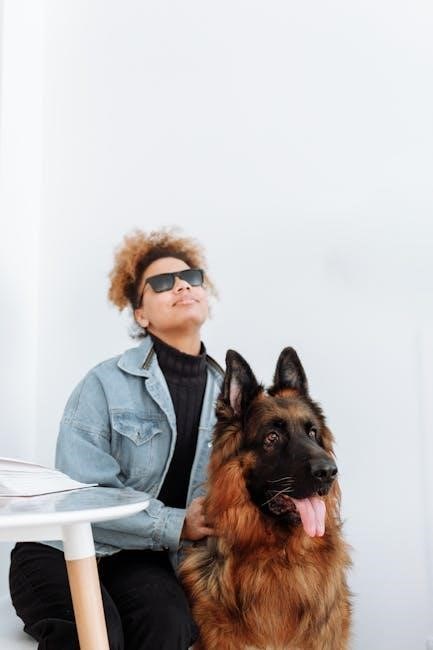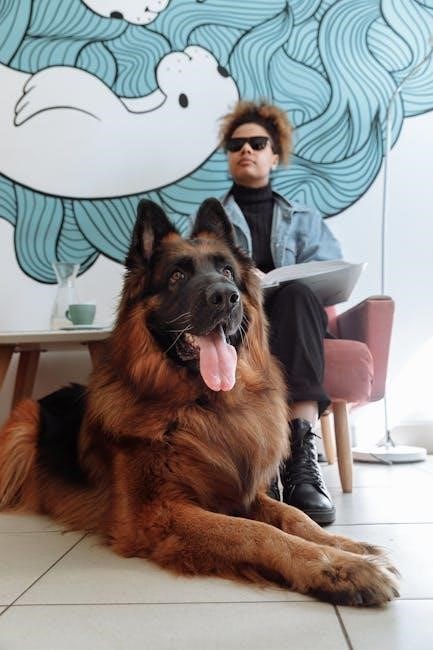
Guide dogs are specially trained to assist visually impaired individuals, providing independence and mobility. Their adoption is a life-changing decision, offering companionship and empowerment.
1.1 What Are Guide Dogs?
Guide dogs are highly trained canine companions specifically bred and educated to assist individuals who are blind or visually impaired. These dogs are taught to navigate obstacles, stop at curbs, and avoid hazards, enabling their handlers to move freely and safely. Typically, breeds like Labrador Retrievers, Golden Retrievers, and German Shepherds are chosen for their intelligence, calm temperament, and strong work ethic. Guide dogs are not pets but working animals, and they are legally permitted to accompany their owners in all public spaces, including restaurants, stores, and public transportation, under accessibility laws.
1.2 The Importance of Guide Dogs for the Blind
Guide dogs play a vital role in enhancing the lives of visually impaired individuals by providing mobility, independence, and confidence. They act as “eyes” for their handlers, enabling them to navigate daily tasks with ease and safety. Beyond physical assistance, guide dogs offer emotional support and companionship, reducing feelings of isolation. Their presence fosters social interaction and community integration, empowering individuals to live fulfilling lives. The impact of guide dogs extends beyond practical assistance, contributing to overall well-being and quality of life for those they serve.
1.3 Brief History of Guide Dogs
The use of guide dogs dates back thousands of years, with evidence of dogs assisting the blind in ancient civilizations like Egypt and Rome. The modern concept of guide dogs emerged in Europe during the 18th century, with formal training programs developing in the late 19th and early 20th centuries. Following World War I, guide dogs became more widespread to assist veterans. Today, organizations worldwide breed and train guide dogs to empower visually impaired individuals, continuing a legacy of service and companionship that has transformed countless lives.

Benefits of Adopting a Guide Dog
Adopting a guide dog enhances independence and confidence, offering emotional support and fostering social connections, while empowering individuals to engage more fully in life.
2.1 Enhanced Mobility and Independence
Guide dogs significantly enhance mobility and independence for individuals with visual impairments. Trained to navigate obstacles and avoid hazards, they empower users to move confidently in various environments. By providing consistent guidance, guide dogs enable users to travel independently, whether walking, using public transport, or exploring new spaces. This newfound freedom fosters a sense of self-reliance and confidence, allowing individuals to engage fully in daily activities and pursue their goals without hesitation. The tailored training of these dogs ensures they meet the specific needs of their handlers, making them invaluable companions for independent living.
2.2 Emotional Support and Companionship
Guide dogs provide more than physical assistance; they offer emotional support and companionship, forming a deep bond with their handlers. This connection reduces feelings of loneliness and isolation, fostering a sense of security and confidence. The presence of a guide dog can uplift spirits, creating a positive outlook on life.Handlers often describe their guide dogs as loyal friends who bring joy and stability to their daily routines. This emotional support is invaluable, enhancing overall well-being and quality of life for individuals with visual impairments.
2.3 Social Interaction and Community Integration
Guide dogs play a significant role in fostering social interaction and community integration for individuals with visual impairments. They often act as conversation starters, helping handlers connect with others in public spaces. The presence of a guide dog can break down social barriers, fostering understanding and inclusivity. Additionally, guide dogs enable their handlers to navigate public environments with confidence, encouraging participation in social activities and community events. This integration enhances overall well-being and promotes a sense of belonging, transforming lives beyond physical mobility.

The Adoption Process
The adoption process involves eligibility checks, detailed applications, and careful matching to ensure the right guide dog is paired with each individual, providing lifelong support.
3.1 Eligibility Criteria for Adoption
Eligibility for adopting a guide dog typically requires applicants to be at least 16 years old, have a genuine need for visual assistance, and demonstrate orientation and mobility skills. A stable living situation, financial stability to cover care costs, and a commitment to training are essential. Applicants must also pass a lifestyle assessment to ensure compatibility with a guide dog. Medical clearance from a healthcare provider is often required to confirm the ability to manage a guide dog effectively. These criteria ensure a successful partnership between the individual and their guide dog, fostering independence and safety.
3.2 The Application and Screening Process
The application process for adopting a guide dog involves submitting a detailed form, which includes personal, medical, and lifestyle information. A review team assesses each application to ensure the individual’s needs align with the capabilities of a guide dog. Home visits and interviews with trained assessors are conducted to evaluate the applicant’s environment and suitability. References may also be required to confirm the applicant’s ability to care for a guide dog. This thorough screening ensures that both the individual and the dog are matched appropriately, setting the foundation for a successful partnership.
3.3 Matching the Right Dog to the Individual
Matching the right dog to an individual involves a detailed assessment of the person’s lifestyle, mobility needs, and living environment. Trained professionals evaluate factors such as the person’s activity level, travel patterns, and specific challenges. The dog’s breed, temperament, and training are then aligned with these needs to ensure compatibility. For example, an active individual might be paired with a high-energy breed like a Labrador Retriever, while someone with a quieter lifestyle might be matched with a Golden Retriever. This personalized approach ensures a strong bond and effective partnership between the individual and their guide dog.

Training and Preparation
Guide dogs undergo comprehensive training, starting with basic obedience and progressing to advanced tasks, ensuring they are well-prepared to assist individuals with visual impairments in various environments.
4.1 Breeding and Initial Training of Guide Dogs
Guide dogs are bred from select breeds like Labrador Retrievers, Golden Retrievers, and German Shepherds, chosen for their intelligence, loyalty, and calm temperament. The breeding process focuses on producing puppies with strong work ethics and adaptability. From 8 weeks old, puppies begin initial training with volunteer raisers who teach basic obedience, socialization, and foundational skills. This early training is crucial for preparing the dogs for advanced tasks later in their development. The puppies are exposed to various environments to enhance their confidence and ability to assist individuals with visual impairments effectively.
4.2 Advanced Training for Specific Needs
After initial training, guide dogs undergo advanced instruction tailored to specific user needs. This phase focuses on refining skills like navigating obstacles, climbing stairs, and crossing streets. Dogs learn to stop at curbs, avoid hazards, and respond to commands in busy environments. Each dog is paired with a certified instructor who teaches them to adapt to the individual’s lifestyle and mobility requirements. Advanced training also includes public access etiquette, ensuring the dog behaves calmly in various settings. Positive reinforcement techniques are used to reinforce learning. This specialized training equips guide dogs to handle complex situations confidently, enabling their users to live independently and safely.
4.3 Public Access Training for Guide Dogs
Public access training prepares guide dogs to navigate various public environments confidently. Dogs learn to remain calm in busy spaces, ignore distractions, and avoid obstacles. This phase includes exposure to restaurants, stores, public transportation, and crowded areas. Handlers and trainers simulate real-life scenarios to ensure the dog remains focused. Positive reinforcement techniques are used to reinforce good behavior. The goal is to ensure guide dogs behave appropriately in all public settings, allowing their users to access essential services and participate fully in community life without restrictions. This training is critical for fostering independence and ensuring seamless integration into public environments.

Common Breeds Used as Guide Dogs
Labrador Retrievers, Golden Retrievers, and German Shepherds are popular breeds for guide dogs due to their intelligence, loyalty, and strong work ethic, making them ideal for assistance roles.
5.1 Labrador Retrievers
Labrador Retrievers are one of the most popular breeds used as guide dogs due to their high intelligence, calm temperament, and strong work ethic. They are highly trainable, which makes them excel in assisting individuals with visual impairments. Labs are known for their loyalty and ability to form strong bonds with their handlers. Their friendly and gentle nature also makes them excellent companions. Additionally, their size and strength are well-suited for guiding tasks. Many guide dog organizations frequently use Labradors because they consistently demonstrate the qualities needed for this vital role. Their adaptability and willingness to please make them a top choice for guide dog training.

5.2 Golden Retrievers
Golden Retrievers are another popular breed used as guide dogs due to their intelligence, loyalty, and gentle nature. They are highly trainable and thrive on pleasing their handlers, making them excellent companions for individuals with visual impairments. Their calm and patient demeanor allows them to navigate challenging environments with ease. Golden Retrievers are also known for their strength and size, which makes them well-suited for guiding tasks. Many guide dog organizations favor this breed for its adaptability and ability to form strong bonds with users. Their friendly disposition and high work ethic make Golden Retrievers a reliable and beloved choice for guide dog roles.
5.3 German Shepherds
German Shepherds are highly intelligent, loyal, and protective dogs, making them an excellent choice for guide dog roles. Their strength, agility, and confident nature enable them to navigate challenging environments effectively. Known for their calm and focused temperament, German Shepherds are well-suited for guiding tasks that require precision and reliability. They are highly trainable and thrive on structure, which is essential for the demanding responsibilities of a guide dog. Their loyalty and ability to form strong bonds with their handlers make them a popular breed for assisting individuals with visual impairments. German Shepherds are also known for their balanced energy, combining diligence with affection, making them both reliable workers and loving companions.
5.4 Other Breeds
Beyond Labradors, Golden Retrievers, and German Shepherds, other breeds like Standard Poodles, Border Collies, and Australian Shepherds are also used as guide dogs. These breeds are chosen for their intelligence, strong work ethic, and calm temperament. Standard Poodles, for instance, are known for their low-shedding coats and high trainability, making them ideal for individuals with allergies. Border Collies and Australian Shepherds excel in agility and focus, which are crucial for navigating complex environments. These breeds bring diversity to guide dog programs, ensuring a wide range of options to match individual needs and preferences. Their adaptability and loyalty make them invaluable companions for visually impaired individuals.

Costs and Funding
Adopting a guide dog involves initial and ongoing expenses, but organizations often provide financial assistance to make it accessible to those in need.
6.1 The Cost of Adopting a Guide Dog
The cost of adopting a guide dog can range from $0 to $50,000, depending on the organization. Many non-profits cover most expenses through donations. Adoption fees often include breeding, training, and placement. Some organizations may charge a nominal fee, while others offer financial assistance. Ongoing costs, such as food, vet care, and equipment, are typically the responsibility of the owner. Scholarships and grants are available to help offset these expenses, making guide dog adoption accessible to those in need.
6.2 Financial Assistance and Scholarships
Financial assistance and scholarships are available to help offset the costs of guide dog adoption. Many organizations, foundations, and advocacy groups offer grants or scholarships to eligible individuals. These programs often cover initial adoption fees or contribute to ongoing expenses. Some organizations partner with donors to provide financial support, while others offer sliding-scale fees based on income. Additionally, certain non-profits specialize in assisting specific groups, such as veterans or students. Researching reputable organizations and reaching out to local resources can help identify available funding opportunities, ensuring that financial barriers do not hinder guide dog adoption.
6.4 Ongoing Expenses
Ongoing expenses for guide dogs include food, veterinary care, and supplies like leashes and harnesses. Annual costs typically range between $1,000 to $2,000, depending on the dog’s size and health needs. Regular check-ups, vaccinations, and preventive medications are essential. Additionally, grooming and hygiene maintenance are necessary to ensure the dog’s well-being. While these costs may seem significant, many organizations offer support or resources to help manage expenses. Budgeting for these recurring costs is crucial to provide a stable and healthy life for your guide dog, ensuring their longevity and effectiveness as a companion.

Legal Rights and Access
Guide dogs are protected under laws like the ADA, ensuring public access and accommodations. Users have legal rights to accompany their dogs in all public spaces.
7.1 Laws Protecting Guide Dog Users
Laws like the Americans with Disabilities Act (ADA) and the Air Carrier Access Act (ACAA) protect guide dog users, ensuring their rights to public access, transportation, and housing. These laws mandate that guide dogs, whether in training or service, are allowed in all public spaces, including restaurants, hotels, and public transportation. Additionally, they prohibit discrimination based on disability, guaranteeing equal opportunities for individuals with guide dogs. These legal protections are essential for promoting independence and inclusivity for visually impaired individuals, ensuring their guide dogs are recognized as indispensable companions.
7.2 Public Access Rights
Guide dog users have the right to access all public spaces, including restaurants, stores, hotels, and public transportation, under disability rights laws. These rights ensure that individuals with visual impairments can navigate freely with their guide dogs. Public access rights promote independence and equality, allowing users to participate fully in society. Businesses and service providers are legally required to accommodate guide dogs, treating them as essential aids rather than pets. This ensures seamless integration into daily life, fostering inclusivity and dignity for guide dog users in all public environments.
7.3 Traveling with a Guide Dog
Traveling with a guide dog is facilitated by legal protections that ensure access to public transportation, hotels, and attractions. Under disability rights laws, guide dogs are permitted in all settings, including airplanes, trains, and taxis. Owners must carry identification and proof of their dog’s training. Advance planning is recommended, such as notifying airlines or hotels about the guide dog. Proper etiquette, like keeping the dog leashed and well-behaved, ensures smooth experiences. Guide dogs are trained to navigate busy environments, making travel accessible and stress-free for their users, while promoting independence and confidence during journeys.

Maintaining a Healthy Guide Dog
Regular veterinary check-ups, balanced nutrition, and grooming are essential for a guide dog’s health. Proper care ensures their well-being and ability to assist effectively.
8.1 Veterinary Care and Vaccinations
Regular veterinary check-ups and preventive care are crucial for maintaining a guide dog’s health. Essential vaccinations, such as rabies, distemper, and parvovirus, protect against deadly diseases. Veterinary care also includes parasite control, dental check-ups, and monitoring for health issues specific to guide dogs. Proper vaccination schedules and preventive medications ensure the dog remains healthy and capable of assisting its owner. Working closely with a veterinarian familiar with guide dogs’ needs guarantees tailored advice and care, ensuring the dog’s well-being and effectiveness as a guide.
8.2 Nutrition and Diet
A balanced and nutritious diet is essential for maintaining a guide dog’s health and performance. High-quality dog food, rich in protein and whole ingredients, supports energy levels and overall well-being. It’s important to avoid fillers and by-products that can hinder digestion. Veterinarians often recommend specific diets based on the dog’s age, breed, and activity level. Proper nutrition ensures the dog remains alert, focused, and physically capable of assisting its owner effectively. Monitoring the dog’s weight and adjusting portions as needed helps prevent obesity and related health issues, ensuring optimal health for years of dedicated service.
8.3 Grooming and Hygiene
Regular grooming is vital for maintaining a guide dog’s health and appearance. Daily brushing helps prevent matting and tangling of fur, while nail trimming ensures comfort during walks. Ears should be cleaned to avoid infections, and teeth brushed regularly for dental health; Bathing is necessary to keep the coat clean, though frequency depends on the dog’s activity level. Proper hygiene also involves cleaning the dog’s harness and collar. Regular veterinary check-ups ensure overall health and address any skin or coat issues early. A well-groomed guide dog not only looks its best but also performs its duties more effectively, ensuring a strong partnership with its owner.

Success Stories and Case Studies
Heartwarming tales of guide dog adoptions reveal life-changing impacts. Inspiring stories highlight their role in empowering individuals, fostering independence, and creating lasting bonds.
9.1 Inspiring Stories of Guide Dog Adoption
Inspiring stories of guide dog adoption highlight the profound impact these dogs have on lives. A heartwarming video captures a blind puppy’s adoption, showcasing the joy and transformation. Real-life experiences share how guide dogs empower individuals, fostering independence and confidence. These stories often reveal the deep bond between handlers and their dogs, demonstrating how they navigate challenges together. Through their journeys, guide dogs prove to be more than just companions—they are life-changing partners; Such narratives inspire others to consider adoption, illustrating the transformative power of these incredible animals.
9.2 Real-Life Experiences of Users
Real-life experiences of guide dog users often highlight the challenges and triumphs of navigating the world with visual impairments. Many users share stories of how their guide dogs transformed their lives, offering newfound independence and confidence. These personal accounts reveal the deep emotional bond between handlers and their dogs, as well as the practical support they provide. Users often emphasize how their guide dogs enable them to engage fully in daily activities, from commuting to socializing. These experiences underscore the profound impact of guide dogs, not just as tools but as trusted companions, inspiring others to explore adoption.
9.3 The Impact of Guide Dogs on Lives
Guide dogs profoundly transform the lives of visually impaired individuals, fostering independence and confidence. They enable users to navigate daily challenges seamlessly, from commuting to social interactions. The emotional bond between handlers and their dogs strengthens mental well-being, reducing feelings of isolation. Guide dogs empower individuals to participate fully in their communities, creating opportunities for personal and professional growth. Their presence not only enhances mobility but also enriches overall quality of life, demonstrating the invaluable role of these animals as both trusted companions and life-changing partners.
Guide dogs profoundly transform lives, offering independence, confidence, and companionship. Their impact extends beyond mobility, enriching emotional and social well-being. Adopting a guide dog can be truly life-changing.
10.1 The Life-Changing Role of Guide Dogs
Guide dogs play a transformative role in the lives of visually impaired individuals, offering unparalleled independence and mobility. Trained to navigate obstacles and guide safely, these dogs empower users to engage fully with their surroundings. Beyond physical assistance, they provide emotional support and companionship, breaking down social barriers and fostering confidence. Their presence enables individuals to pursue daily activities, careers, and hobbies with renewed freedom. The bond between a guide dog and its handler is deeply rewarding, creating a partnership that enhances overall quality of life. This life-changing relationship highlights the profound impact of guide dogs on both practical and emotional levels.
10.2 Encouraging Others to Adopt
Encouraging others to adopt guide dogs can profoundly impact lives, offering independence and empowerment to the visually impaired. Organizations like Guide Dogs for the Blind provide comprehensive support, ensuring a seamless adoption process. By sharing the transformative benefits of guide dogs, we inspire others to consider this life-changing decision. Every adoption not only enhances mobility but also fosters emotional well-being and social integration. Spreading awareness and promoting adoption can create a ripple effect, helping more individuals gain the confidence and freedom they deserve through these incredible companions.